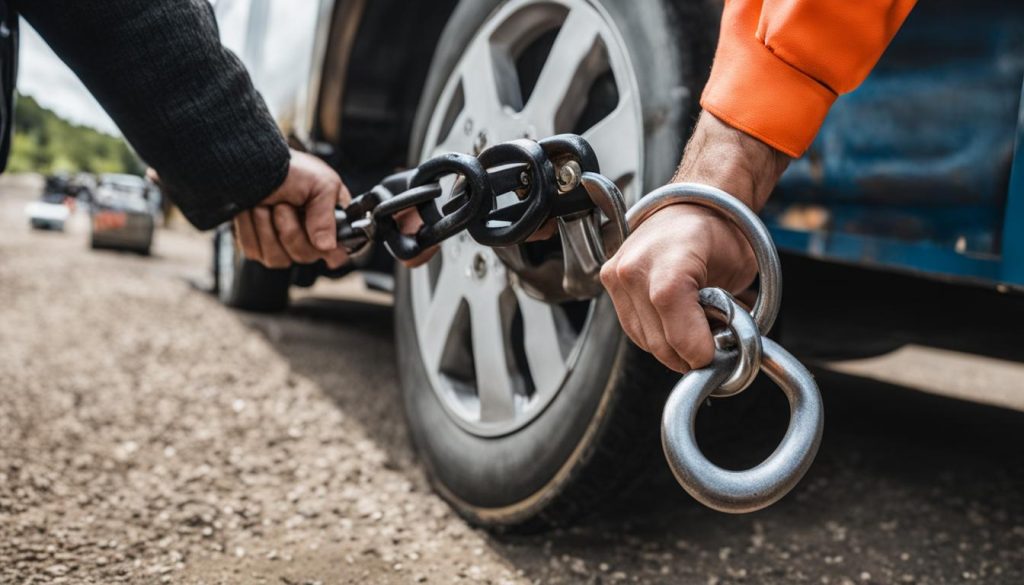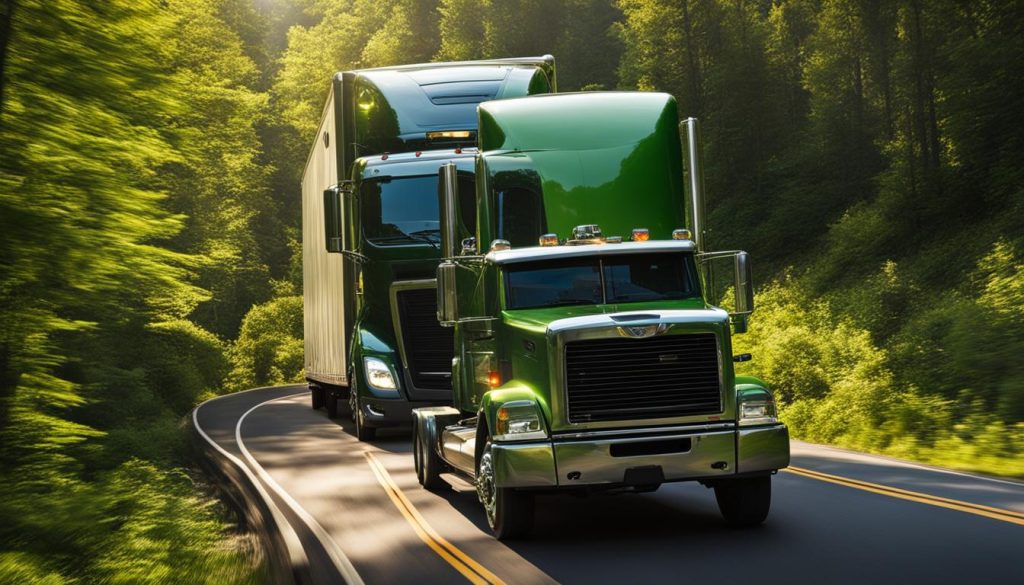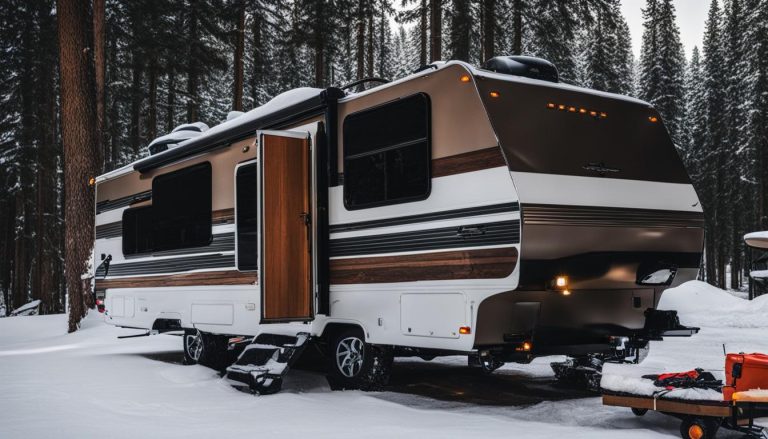Essential Towing Basics & Tips for Safe Transport
gorvlifestyle.com and its partners may earn a commission if you purchase a product through one of our links
Navigating the highways with an additional load requires more than just a steady hand on the wheel. Whether one is hauling a small trailer or steering a full-size RV across state lines, understanding the Towing Basics is vital. These foundational tips provide the necessary know-how for converting an uninitiated driver into a confident tower, capable of guiding their cargo safely to its destination. At every mile, safety precautions for towing must be prioritized to avoid any mishaps on the road. It involves an intricate dance of checking, balancing, and securing—repeatedly until it becomes second nature.
For those who seek to master the finer points of this skill, maneuvering tips for towing become an essential part of the journey. Preparing one’s vehicle for the task ahead means assessing and understanding its capabilities fully. Consequently, employing best practices for towing ensures both the safeguarding of one’s cargo and the wellbeing of fellow travelers. The ultimate goal is a seamless journey from point A to point B, with peace of mind intact and the cargo in pristine condition.
Key Takeaways
- Grasping towing essentials is crucial for safe and efficient transport.
- Adhering to specific safety precautions can prevent potential dangers while towing.
- Knowing maneuvering tips is necessary for adjusting to the unique requirements of towing.
- Understanding your vehicle’s towing capabilities is foundational.
- Regular maintenance checks on both vehicle and trailer are essential proxies for transport security.
- Following best practices is paramount in protecting both the towed cargo and the towing vehicle itself.
Understanding Towing Capacity and Vehicle Limitations
When delving into Towing Basics, comprehending your vehicle’s capacity and limitations is the foundation of secure and effective towing. Before attaching any trailer, it’s essential to arm yourself with knowledge about your vehicle’s weight capabilities and understand the nuances of the trailer hitch types that are compatible with your vehicle.
Identifying Your Vehicle’s GVWR and Curb Weight
Every vehicle on the road has a set Gross Vehicle Weight Rating (GVWR), which points to the maximum weight your vehicle can safely operate with, encompassing the weight of the vehicle itself, its passengers, cargo, and any additional load like a trailer. To ensure you stay within safe limits, it’s crucial to know your vehicle’s curb weight—the weight of the vehicle without passengers or cargo—which can typically be found in the owner’s manual or a placard on the driver’s side door.
Calculating Towing Capacity and Tongue Weight
Understanding your vehicle’s towing capacity ensures you avoid the risks that come with overloading. A towing capacity calculator can be a handy tool in this regard, offering a quick way to determine if your vehicle can handle the weight of a certain trailer. Enter information, such as your car’s make and model, to get precise data. Additionally, the tongue weight, or the downward force that the trailer exerts on the hitch of the tow vehicle, should ideally be between 10-15% of the trailer’s total weight for balanced towing. Selecting the right trailer hitch types to bear this weight safely is just as critical.
The successful transportation of your cargo requires meticulous attention to these capacity details, which in turn ensures a safe and stress-free towing journey.
Towing Basics (hitch types, safety precautions, maneuvering)
Embarking on the journey of towing requires a fundamental understanding of hitch types, meticulous trailer hitch installation instructions, and stringent safety precautions. It is not merely about attaching a trailer; it is about ensuring a harmonious travel between your vehicle and the cargo it tows. With a variety of hitch types available, one must select the appropriate hitch that corresponds with their vehicle’s make and model, as well as the weight and type of the trailer.
Choosing the Right Hitch Ball is a critical aspect of the towing process. The hitch ball must perfectly match the trailer’s coupler size, and it’s vital for maintaining a secure connection throughout your travel. This precision prevents the trailer from dislodging, which could lead to serious road hazards.
When it comes to trailer hitch installation instructions, each step should be followed with attention to detail. It ensures not just a secure installation but also peace of mind. From safely securing the hitch ball to ensuring that the electrical wiring is correctly connected, the installation process is the backbone of towing safety.
Practicing safety precautions for towing is another vital element. Here are essential precautions to always consider:
- Regularly check hitch assembly and couplings for wear and tear
- Ensure all towing parts are properly lubricated
- Use tow mirrors to improve visibility, essential for maneuvering in traffic
- Always connect safety chains in a crisscross pattern under the hitch
- Consult the vehicle’s manual for maximum towing capacities to avoid overloading
- Inspect all lights and signals for correct synchronization between your vehicle and the trailer
Remember, safety first! When it comes to towing, never compromise on the quality of equipment or skip on any installation and safety steps. Your diligence will keep you, your cargo, and fellow drivers safe on the road.
Understanding the towing basics — from selecting the correct hitch type to implementing essential safety measures — is not only necessary but imperative for a steadfast towing experience. Proper education and practice of these principles will result in a towing endeavor where both driver and cargo arrive safely and securely at their destination.
Essential Gear for Towing: Hitch Types and Uses
When it comes to towing vehicles, having the right equipment at hand is not a luxury—it’s an absolute necessity for ensuring the safety and reliability of your transportation process. Among the variety of towing equipment essentials, particular attention must be given to the selection of an appropriate hitch, which serves as the linchpin for a secure connection between your vehicle and your trailer.
Exploring Receiver Hitches and Their Ratings
Receiver hitches are a staple in the towing sphere, known for their versatility and broad compatibility with various vehicles. They are classified based on different weight ratings, ensuring they can handle anything from the lightest of cargo carriers to the most substantial of travel trailers. A prime consideration when selecting a receiver hitch is to ensure it aligns with your vehicle’s towing capacity. Mounting directly to the vehicle’s chassis, these hitches offer the stability and durability required for towing endeavors.
The Advantages of Weight Distribution Hitches
For those embarking on towing heavier loads, weight distribution hitches are the go-to gear. These hitches excel in enhancing stability by evenly distributing the trailer’s load across the length of the towing vehicle, preventing the common pitfall of trailer sway. The design includes spring bars that provide tension to help level out the vehicle and trailer, which not only greatly improves vehicle handling but also reduces wear on the towing vehicle’s suspension over time.
- Minimizes strain on the towing vehicle: A weight distribution hitch redistributes weight to ease the load on the rear of the towing vehicle.
- Boosts control and handling: By evening out the weight distribution, these hitches aid in creating a more level ride, which translates to better steering and braking control.
- Reduces risks of trailer sway: The even distribution of weight is crucial in preventing the trailer from swaying, which is particularly important in adverse driving conditions or when passing larger vehicles.
Investing in proper towing equipment, such as receiver and weight distribution hitches, not only enables you to transport your cargo more efficiently but also contributes significantly to road safety. Remember, the key to a successful tow lies in matching your towing equipment to the task at hand, ensuring a seamless ride regardless of the destination.
How to Properly Hitch a Trailer to Your Vehicle
Ensuring a secure connection is key when it comes to hitching a trailer. It’s not just about the connection itself, but also about implementing vital steps such as securing safety chains and ensuring that your trailer lights are in sync with your towing vehicle for a safe journey.
Matching the Hitch Ball to the Trailer Coupler
When dealing with trailer hitch installation instructions, the first step is to accurately match the hitch ball to the trailer coupler. It’s crucial that these sizes match for the security of your connection. Hitch balls typically come in three sizes:
- 1⅞ inches
- 2 inches
- 2 5⁄16 inches
This compatibility ensures a snug fit, reducing the risk of the trailer detaching while on the move. Always double-check that the selected hitch ball corresponds properly with your trailer.
Securing Safety Chains and Electrical Connections
After you’ve matched the hitch ball with the trailer coupler, securing the safety chains becomes the next critical step. Cross the safety chains under the trailer tongue to give your trailer a backup connection if it becomes detached. Correct positioning also allows for full maneuverability during turns without chains dragging on the ground.
Properly secured safety chains act as a foundational safety net for your towing setup, ensuring an additional layer of security.
Additionally, it’s imperative to hook up the electrical connections properly. This includes connecting the trailer lights—ensuring that signals and brake lights are functioning in harmony with the towing vehicle. Thorough testing of these lights before setting off is not just a safety measure, it’s also a legal requirement.
Consult the following table to ensure that your safety measures are up to standard:
| Safety Measure | Description | Checklist |
|---|---|---|
| Hitch Ball and Coupler Match | Ensuring the sizes between hitch ball and trailer coupler align. | Measure hitch ball and coupler; verify snug fit. |
| Securing Safety Chains | Crossing chains under the trailer tongue for security. | Chains crossed and have enough slack for turns. |
| Electrical Connections | Linking trailer lights to the towing vehicle. | Test all signals and brake lights before departure. |

For a successful towing experience, pay close attention to these key aspects of hitching your trailer. With the right preparation and careful execution of these steps, you’ll be set for a safe transit to your destination.
Towing Safety Guidelines to Prevent Accidents
Ensuring safety while towing is paramount and requires a solid understanding of towing safety guidelines. Especially for those new to towing, following a beginner towing guide can greatly reduce the risk of incidents. Central to these guidelines is the knowledge of trailer hitch types and their proper usage. Let’s explore some crucial practices that are instrumental in preventing towing mishaps.
- Regularly check the tire pressure of both the tow vehicle and trailer, ensuring they match recommended levels for stability and efficiency.
- Ensure your spare tire is accessible and in good condition, as it’s a vital part of towing preparedness.
- Properly torque wheel lug nuts to manufacturer specifications to avoid wheel detachment.
- For trailers equipped with brakes, conduct regular inspections and make necessary adjustments.
- Avoid overloading the trailer; balance the load to maintain control and minimize the risk of tip-overs or loss of direction.
- Comprehend the altered dynamics of your vehicle once a trailer is attached, such as in maneuverability and increased stopping distances.
- Employ a spotter when reversing to prevent collisions with objects or other vehicles.
- Disconnect trailer wiring before launching any watercraft to protect electrical systems from water damage.
Adhering to these guidelines not only enhances safety but also extends the lifespan of both your towing equipment and the cargo being transported.
| Trailer Hitch Type | Typical Use Case | Vehicle Compatibility |
|---|---|---|
| Receiver Hitch | General Towing, Bike Racks | SUVs, Trucks, Sedans |
| Fifth Wheel Hitch | Heavy Trailers, RVs | Large Pickup Trucks |
| Gooseneck Hitch | Industrial & Agricultural Use | Flatbed and Heavy-Duty Trucks |
| Weight Distribution Hitch | Larger, Heavier Loads | SUVs, Vans, Trucks |
| Pintle Hook | Commercial and Military Trailers | Lorries, Large Trucks |
For every towing scenario, there is an appropriate hitch type to ensure a safe and secure connection. Matching the correct trailer hitch type to your towing vehicle is not only a best practice but a necessary step toward accident prevention.
Pre-Trip Inspections for a Smooth Towing Experience
Embarking on a journey with a towed trailer necessitates diligent pre-trip inspections to avoid potential hiccups along the way. Such inspections are pivotal to confirm the readiness of your towing arrangement and to ensure compliance with safety standards.
Checking Tires on Both Vehicle and Trailer
One of the towing equipment essentials that must not be overlooked is the condition of the tires on both your vehicle and the trailer. An inspection should encompass air pressure checks for optimal performance and fuel efficiency. Beyond pressure, scrutinizing the tire treads for excessive wear and looking for damages like cuts or bulges cannot be missed. Seasoned travelers know that the longevity of their tires greatly impacts the towing dynamics.
Ensuring Your Lights and Signals Are Synchronized
For the unified operation of a towing vehicle and its trailer, having synchronized trailer lights is a necessity, not only for legal compliance but for the safety of all road users. By aligning your trailer’s brake lights, turn signals, and clearance lights with your vehicle, you convey your intentions clearly, minimizing chances of misinterpretation or accidents.
Regularly testing the electrical connections before setting off ensures that signals sent from the vehicle are properly received and displayed by the trailer. This harmony in communication is what differentiates a safe towing experience from a risky one.

Maneuvering Tips for Towing: Mastering the Drive
Towing a trailer can transform any drive into a complex undertaking that demands specific driving techniques and heightened awareness. With maneuvering tips for towing, you can enhance your driving mastery, ensuring safety for you, your cargo, and fellow road users. Here, we delve into essential strategies for executing wider turns with a trailer and adjusting to longer braking distances when towing, integrating these towing safety guidelines into your navigation repertoire.
Executing Wider Turns with a Trailer
When towing, the additional length behind your vehicle means your turns should be wider than usual to avoid clipping curbs or verges. It’s essential to begin your turn later than you would in a solo vehicle, monitoring the trailer’s path and adjusting accordingly to prevent potentially hazardous mishaps.
Adjusting to Longer Braking Distances When Towing
To ensure road safety while towing, understanding the impact of your trailer’s weight on your braking distances is critical. Anticipating stops and giving yourself a generous distance to slow down and halt is fundamental to prevent rear-end collisions. Trailer brakes can significantly aid in managing your tow vehicle’s stopping power, mitigating the risk of brake failure and associated towing accidents.
- Maintain a safe following distance – Given that the weight of the trailer can double or even triple stopping distances, always keep enough space between your vehicle and the one ahead.
- Test your trailer brakes – Before setting off, ensure that your trailer’s brakes are properly connected and functioning. Adjust them based on the load’s weight for optimal performance.
- Use engine braking when possible – Downshifting to lower gears can help slow the vehicle without relying solely on the trailer brakes, easing the stress on the brake system during long descents or stop-and-go traffic.
| Towing Scenario | Maneuvering Tip | Safety Consideration |
|---|---|---|
| Making Right Turns | Swing out wider to accommodate trailer’s inner tracking | Watch for vehicles in your right blind spot. |
| Highway Driving | Choose the rightmost lane for easy access to shoulder if necessary | Keep an eye on trailer sway and adjust speed accordingly. |
| Urban Stop-and-Go | Increase following distance and anticipate stops | Be alert for pedestrians and cyclists especially near crosswalks. |
It’s not only about reacting to the road conditions, but also proactively planning your maneuvers. Integrating these towing safety guidelines into your preparation can significantly mitigate risks. Trailing takes practice, but with these maneuvering tips for towing and an understanding of trailer brakes and their operation, you’re set for a safer journey.
Towing Equipment Essentials: What You Need Before Hitting the Road
Embarking on a journey with a trailer in tow demands meticulous preparation to ensure safety and compliance with towing safety guidelines. The foundation of a robust towing setup is the gear that facilitates a safe and efficient towing experience. From the efficiency of trailer brakes to the clarity offered by tow mirrors, these are the components that should not be overlooked by any responsible tower.

The Importance of Reliable Trailer Brakes
Ensuring that your trailer can stop efficiently is just as important as your tow vehicle’s braking capability. A well-maintained set of trailer brakes is a critical component, particularly for heavy loads where the additional momentum requires controlled deceleration. Electric brakes are increasingly popular due to their adjustability, providing precise control that can be tailored to the weight of the trailer and its cargo.
Extended Tow Mirrors for Visibility
When it comes to towing, visibility is a non-negotiable. Extended tow mirrors provide a wider field of view, which is essential for safe lane changes, reversing maneuvers, and overall situational awareness. Enhanced visibility directly impacts towing safety, allowing drivers to respond to the traffic environment more effectively and make informed decisions on the road.
| Towing Essential | Role in Safety | Additional Benefits |
|---|---|---|
| Trailer Brakes | Provides needed stopping power | Adjustable settings for different loads |
| Tow Mirrors | Enhances rearward visibility | Boosts confidence during lane changes and reversing |
| Wheel Chocks | Prevents a stationary trailer from rolling | Easy to store and install |
| Hitch Lock Systems | Secures trailer to prevent theft | Gives peace of mind when unhitching |
To aptly prepare for towing, investing in the quintessential towing equipment essentials leads to a more predictable and safe driving experience. Ensure these fundamental items are accounted for and in good working order to uphold the highest standards of towing safety.
Trailer Hitch Installation Instructions for Beginners
Embarking on the journey of towing begins with a fundamental task: installing your trailer hitch. For the untrained, the process can seem daunting, but with a detailed beginner’s towing guide, you can confidently secure your cargo for the road ahead. Understanding the wide array of trailer hitch types is equally imperative, as a mismatched hitch can lead to unsafe towing conditions. Below are clear cut trailer hitch installation instructions to guide you through each step of the process.
Before diving into the installation process, it is essential to ensure that the trailer hitch is compatible with your vehicle’s make and model. Retailers and manufacturers provide vital resources including diagrams and video tutorials that ensure smooth setup. If you’re considering a DIY approach to installing wiring for towing trailers, these tutorials can prove invaluable. Otherwise, seek professional assistance from either a dealership or a trusted auto shop to ensure proper synchronization of your trailer’s lighting with your vehicle.
- Verify the hitch type matches your vehicle and towing needs.
- Gather necessary tools and follow the provided guide or tutorial closely.
- Securely bolt the hitch to predetermined locations under your vehicle.
- Connect and test the wiring for brake lights and turn signals.
- Seek professional help if the task surpasses your comfort level.
| Hitch Type | Vehicle Compatibility | Loading Capacity |
|---|---|---|
| Receiver Hitch | Passenger vehicles, SUVs | Class I-IV |
| 5th Wheel Hitch | Pickup trucks | Up to 25,000 lbs |
| Gooseneck Hitch | Heavy Duty pickup trucks | Up to 30,000 lbs |
Meticulously following trailer hitch installation instructions provides the groundwork for secure and safe towing. Whether you are just a beginner or somewhat familiar with towing, a methodical approach ensures that your foundation in towing is solid and dependable.
Best Practices for Towing to Protect Your Cargo and Vehicle
When it comes to safe and successful towing, mastering the best practices can make all the difference. Ensuring that the cargo is firmly secured and the vehicle is prepped to handle the task at hand not only protects your load but also contributes to the safety of everyone on the road. Towing safety guidelines advocate for meticulous attention to detail in every step of the towing process, from the way cargo is loaded to the choice of route taken. Let’s delve into the specifics that elevate your towing practices.
Proper Loading Techniques for Balance and Stability
Balance and stability are the cornerstones of secure towing, and they start with proper loading techniques. The key is to distribute the weight of the load evenly across the trailer. Heavier items should be placed low and towards the center, with enough weight at the front to maintain the necessary tongue weight, yet not so much as to unbalance the driving dynamics of the towing vehicle. By adhering to strategic loading techniques, you minimize the risk of trailer sway and enhance overall vehicle control, keeping both the cargo and vehicle stable and secure throughout your journey.
Route Planning to Avoid Low Bridges and Restricted Roads
Advance route planning emerges as a vital aspect of the towing process, as it can prevent encounters with low bridges, restricted roads, and other hazards that might compromise safety or legality. Utilizing resources that help identify optimum pathways for your specific setup, with consideration for trailer height and weight limitations, can spare drivers from last-minute detours and risky maneuvers. Such foresight in route planning not only promotes a smoother journey but also ensures that you and your cargo arrive at your destination without unwanted surprises or infractions.






